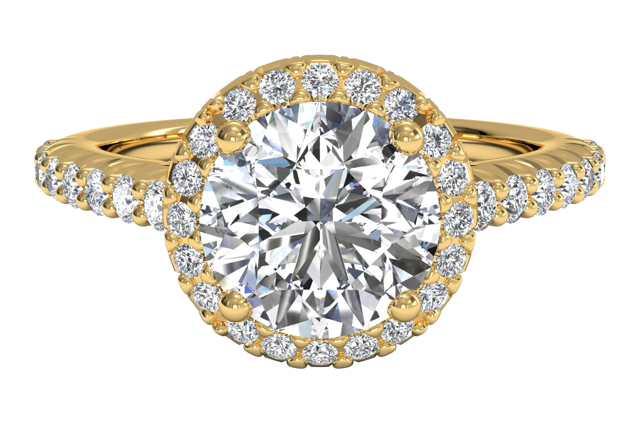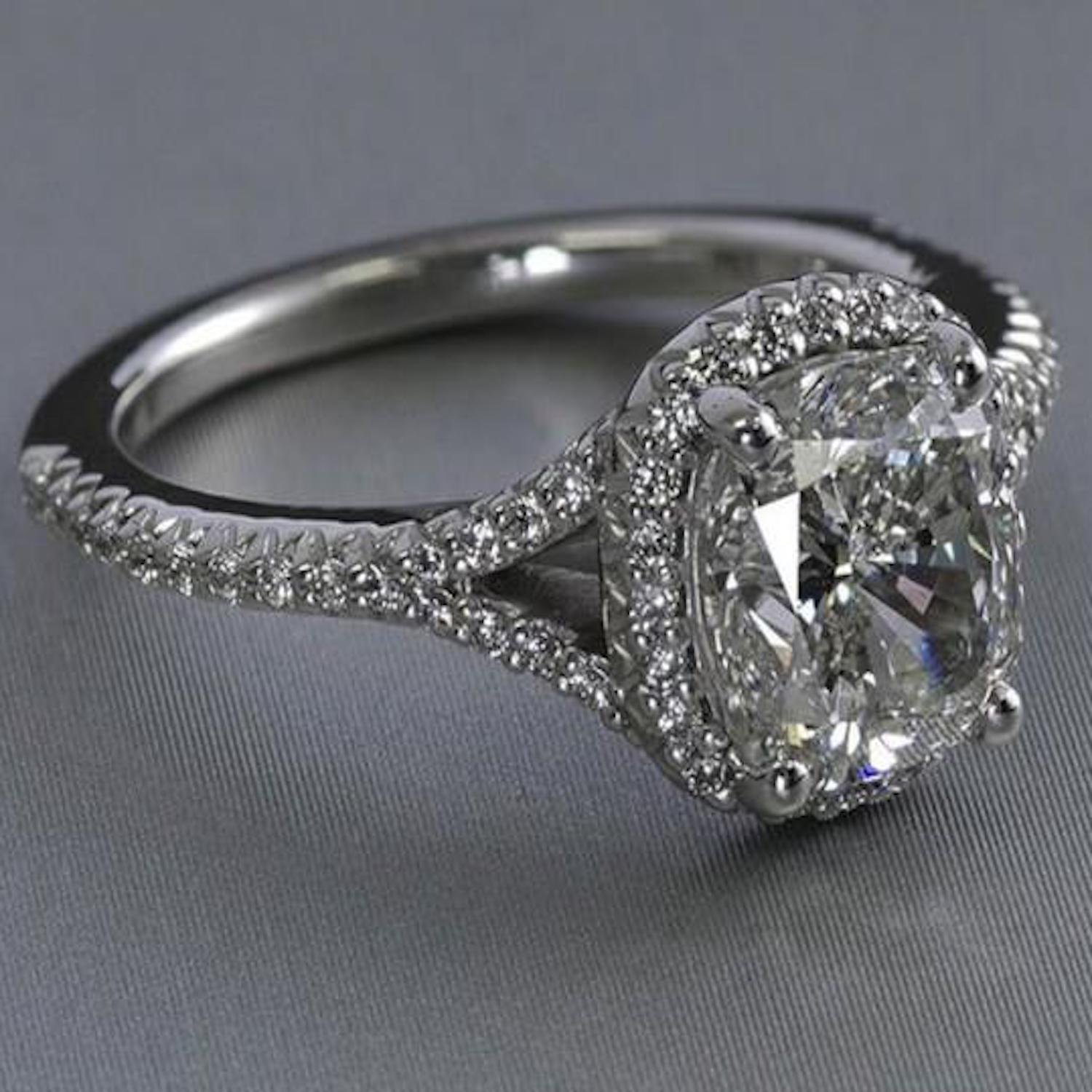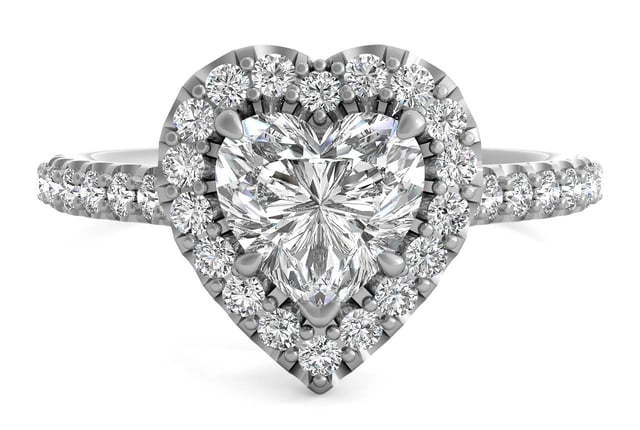Sidestone Engagement Rings: The Ultimate Buying Guide
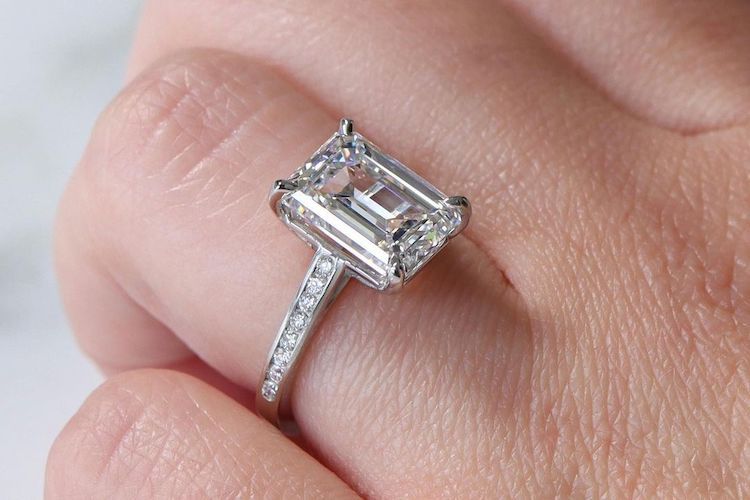
Looking for a sidestone engagement ring? You’ve got great taste. This timeless engagement ring style is one of the most sought-after.
What is a sidestone engagement ring?
Sidestone engagement rings, which are sometimes called diamond band engagement rings or diamond accent engagement rings, feature diamonds lining the band for additional sparkle and glamour. These differ from solitaire engagement rings, another popular style that has a plain band.

Choosing Your Center Stone
Before going into choosing the right setting, we’re going to teach you how to pick the star of the show: your diamond center stone.
Popular Diamond Shapes
Any diamond shape will look stunning in a sidestone setting. The diamond center stone shape is one of the most critical aspects of your ring to consider, especially if you are shopping for someone else since each shape conveys a different style and personality.
Round-Cut Diamonds

Round-cut diamonds are the #1 best-selling shape. This timeless diamond shape offers the most scintillation and brilliance. Be aware that this is the most expensive diamond shape.
Emerald-Cut Diamonds
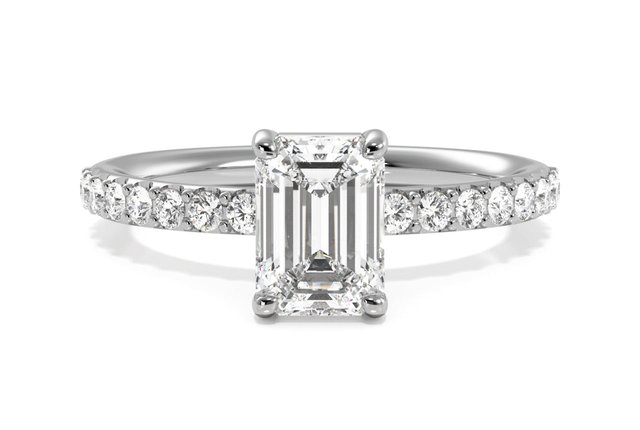
The emerald-cut is a step-cut diamond, meaning it is cut to emphasize the beauty of a diamond’s clarity rather than sparkle. In other words - emerald-cut diamonds don’t sparkle very much. For this reason, these glamorous diamonds pair beautifully with sidestone engagement rings – the extra diamonds in the band will add additional sparkle to an emerald-cut engagement ring.
Cushion-Cut Diamonds

The cushion-cut diamond is square in shape with soft, rounded corners. This romantic diamond, which has antique roots, will make a lovely choice for your engagement ring.
Oval-Cut Diamonds

The oval-cut diamond is one of 2022’s best-selling shapes, and with good reason: the elongated diamond shape flatters your finger by creating the illusion of a longer, slenderer finger. It’s full of sparkle and appears larger than other diamond shapes like the cushion or round-cut.
The 4 Cs
The 4 Cs are the universal standard to determine the quality and value of a diamond. They stand for Cut, Color, Clarity, and Carat.
Cut
This measures how well the diamond was cut. Cut is important because it heavily affects the beauty of a diamond – a poorly cut diamond will not produce much sparkle. Stones that aren’t cut well can also appear smaller!
For round-cut diamonds, choose an Ideal cut diamond. Fancy shapes don’t receive a cut grade from most agencies, but we give them cut grades at Ritani. Look for a fancy-shaped diamond with a Very Good cut. You should also choose a diamond with Excellent polish and Excellent symmetry grades to ensure a stunning stone.
Color
Color is a measure of how much (or how little) color a diamond reflects. Most diamonds will naturally have a faint yellow or brown hue; this isn’t a defect.

At Ritani, we offer diamonds from D to L. D color diamonds are completely colorless, while L color diamonds will have a faint yellow appearance. Colorless diamonds are the most expensive since they are rarer. We recommend selecting near-colorless stones, which will still appear white but are much more affordable.
Clarity

Most diamonds naturally have inclusions, which are internal imperfections in the diamond. Some inclusions aren’t noticeable, while others can have an obvious impact on the beauty of the diamond. We encourage shoppers to look for eye-clean diamonds instead of choosing Flawless or Internally Flawless diamonds, which are very rare and thus very expensive. We recommend choosing diamonds with a clarity grade of VS2 or better. SI1 and SI2 diamonds can sometimes be eye-clean, but are not always, so make sure to view HD imagery and videos of your diamond before buying it. If videos or images are not available for a particular stone, feel free to contact us.
Carat
Carat is a measure of how much a diamond weighs. One carat is equivalent to 200 milligrams. As mentioned earlier, not all diamonds will look the same size – two diamonds that are the same carat weight can appear to be different sizes due to how they are cut.
Carat has the biggest impact on a diamond’s price. The carat weight you choose for your diamond is up to you, your tastes, and your budget.
Earth-Grown Diamonds vs Lab-Grown Diamonds
Not all diamonds are formed underground! Most of the diamonds we sell today at Ritani are lab-grown diamonds. Lab-grown diamonds are manmade stones that are completely identical to diamonds. They are 100% real diamonds and will test as real diamonds. The benefit of lab-grown diamonds is their price point; a lab-grown diamond can cost 30-50% less than a mined diamond. However, some prefer the classic appeal of earth-grown diamonds. Ultimately, it’s up to you which type of diamond you choose – there is no right or wrong answer.
READ MORE: LAB-GROWN VS NATURAL DIAMONDS
Choosing a Sidestone Engagement Ring
Diamond Sidestone Shapes

The diamonds set in engagement ring bands aren’t always round-cut diamonds, like in the ring shown above. Round-cut diamonds are the most popular side stone shape, but side stones can be practically any shape! Here are some popular side stone shapes that you’ll see in diamond rings.
Baguette-Cut Diamonds

Baguette-cut diamonds are step-cut diamonds, like the emerald-cut, meaning they are cut to highlight the stone’s clarity rather than sparkle. Baguette-cut diamonds add a sophisticated, vintage look to any diamond band engagement ring.
Marquise-Cut Diamonds

Marquise-cut diamonds have a pointed, football-like shape. These diamonds are often used as leaf-like details in floral-inspired rings, like in the Vintage Floral Diamond Engagement Ring shown above. The marquise-cut is full of sparkle and will flatter any diamond center stone shape.
Pear-Cut Diamonds

Like the marquise-cut, but with one rounded side, the pear-cut diamond will add an exquisite touch to your engagement ring and pair beautifully with any diamond center stone shape.
Princess-Cut Diamonds

Princess-cut diamonds provide clean lines and lots of sparkle, adding a modern touch to any engagement ring.
Illusion Sidestone Shapes

Some band engagement rings utilize the setting to create the illusion of certain diamond shapes in the band. For example, the engagement ring above uses metal to create the appearance of marquise and round-cut diamonds, but the band is completely lined with round-cut stones. This is a common technique - using round-cut diamonds instead can be beneficial since they are the most sparkly shape and pointed shapes like the marquise-cut are prone to chipping.
Diamond Setting Styles
Diamonds can be set in the band in a variety of different ways. Each setting style provides a different look as well as different benefits.
French-Set Diamonds

This is a setting style that you will see very frequently in engagement rings. When diamonds are French set, each diamond is raised in the band by tiny prongs. Since each diamond is raised, lots of light can enter each stone, creating perfect sparkle.
Pavé Diamonds

Pavé means “paved” or “cobblestone” in French. In a pavé setting, your band will literally look like it has been paved with diamonds! Each diamond is secured by tiny beads and is set deep into the band rather than raised. This setting style creates a delicate, graceful effect.
Micropavé Diamonds

A micropavé-style setting sets diamonds the same way as a pavé setting, but even tinier diamonds are used, allowing for multiple rows of diamonds. Like pavé diamonds, micropavé diamonds are an excellent choice for someone who is seeking an exquisite, graceful look.
Bezel-Set Diamonds

In a bezel setting, a rim of metal surrounds each diamond to secure it. This is one of the most secure setting styles and would be ideal for someone with a more active lifestyle.
Channel-Set Diamonds

This is another extremely secure setting ideal for those with active lifestyles. In a channel setting, diamonds are set in a groove, then are held in place by two thin bars of metal covering the edges of the diamonds.
Sidestone Engagement Ring Styles
Aside from the classic look of a single row of diamonds lining the band, here are some other common sidestone engagement ring styles.
Three-Row Engagement Rings

Three-row engagement rings feature diamonds lining all 3 sides of the band for sparkle at all angles. This elegant style typically uses pavé or micropavé diamonds.
Cluster Engagement Rings

These engagement rings feature a cluster of diamonds that complement the center stone. Sometimes cluster engagement rings will feature mixed diamond shapes in the band as well for an eclectic look.
Gemstone Engagement Rings

Some engagement rings will feature a mix of gemstones and diamonds in the band for a colorful look. The ring above features diamonds and sapphires in the band. Consider adding your and/or your partner’s birthstone to the band for a sentimental touch!
Knife-Edge Engagement Ring

Knife-edge engagement rings are a best-seller at Ritani. Knife-edge engagement rings utilize a pointed, angular band for a captivating look. Typically, knife-edge rings feature a plain metal band, but sometimes you will come across diamond-studded knife-edge bands like in the ring above.
Learn More About Knife-Edge Engagement Rings
Split Shank Engagement Rings

Get even more diamonds with a split shank engagement ring. In split shank engagement rings, the band is divided, creating a dramatic effect.
Double-Row Engagement Rings

Why have one row of diamonds when you can have two? The extra row of diamonds will create an eye-catching look for even more sparkle.
Metals
There are a variety of metals to choose from for your engagement ring.
White Gold
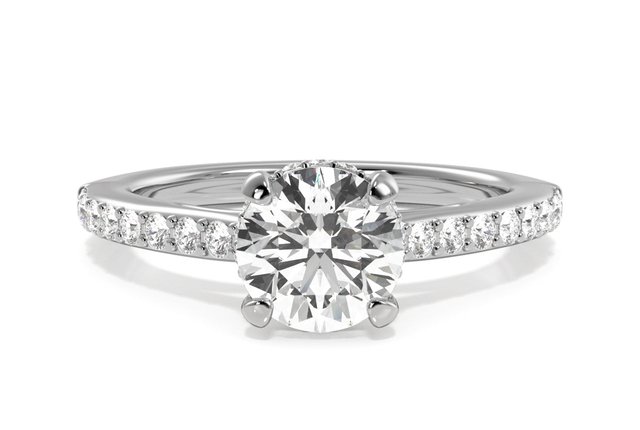
White gold is a durable silver-colored metal that is similar in appearance to platinum but is much more affordable. White gold contains gold, but it is mixed with silver-toned metals like nickel and zinc to get its white color. White gold is also rhodium plated. Over time, this plating will wear off, and you will need to get the ring re-plated to restore it to its original luster. At Ritani, we offer free re-plating once a year for our white gold engagement rings.
Learn More About Our Lifetime Manufacturing Warranty
Yellow Gold

This warm-colored metal has made a huge comeback in recent years. It does not require re-plating like white gold. Yellow gold is durable and will last for decades to come.
Rose Gold

This unique and romantic metal gets its color from copper mixed with gold. Like yellow gold, it does not require any additional maintenance. Rose gold is also very durable and will last for decades.
Platinum

Platinum is hypoallergenic and extremely durable. Since it is very rare, it is much more expensive than gold.
Buying Tips
Avoid Eternity-Style Bands
We recommend that you stay away from eternity-style bands (bands with diamonds going the way around the finger) because they cannot be resized. If your finger size ever changed, you would have to re-set your center diamond in a new setting.
Active Lifestyles
Diamond jewelry isn’t indestructible, and diamond band engagement rings aren’t necessarily the best choice for those who work with their hands or have active hobbies. This is because diamonds can become knocked out of the ring and lost. We recommend channel settings or bezel settings for your side stone engagement ring if you fall under the “active” category as these are the most secure settings.
Maintenance Tips
Once you purchase your sidestone engagement ring, follow these maintenance tips.
Know when to take your ring off.
As discussed, diamonds can be lost from your ring if you knock your ring too hard, or if your ring gets caught on things like fabric. Take off your ring anytime you are doing manual labor, cleaning, swimming, before going to bed, or in any situation where you are actively using your hands.
Get your ring checked.
We recommend having your ring examined by a jeweler every 6 months. Your jeweler can check to make sure all the prongs are secure or fix any loose prongs in order to prevent diamonds from falling out. Plus, this gives you the opportunity to get your ring professionally cleaned to restore it to its original luster!
RELATED: A Diamond Fell Out of My Ring – What Do I Do?
FAQs
What are melee diamonds?
Melee (pronounced meh-lee) is a fancy term for the tiny diamonds used in diamond jewelry. Diamonds in the band of your engagement ring are considered melee diamonds.
What does ctw mean?
“CTW” stands for Carat Total Weight. For example, you may see an engagement ring setting described as being 0.50 ctw – this just means all the diamonds in the setting add up to 0.50 carats total.
What does tcw mean?
“TCW” stands for Total Carat Weight. It is the same thing as CTW. If you see an engagement ring setting listed as having a 1 TCW, it means that all the diamonds in the setting add up to 1 carat.
What are diamond points?
In diamond jewelry, you may have heard tiny diamonds be described as “points.” 100 points are equivalent to 1 carat. So, for example, if someone describes the diamonds in your band as 10-point diamonds or 10-pointers, each diamond is 0.10 carats.
Can you add diamonds to an engagement ring band?
In this case, it would be easiest to have your center diamond reset into a new diamond-embellished setting.
